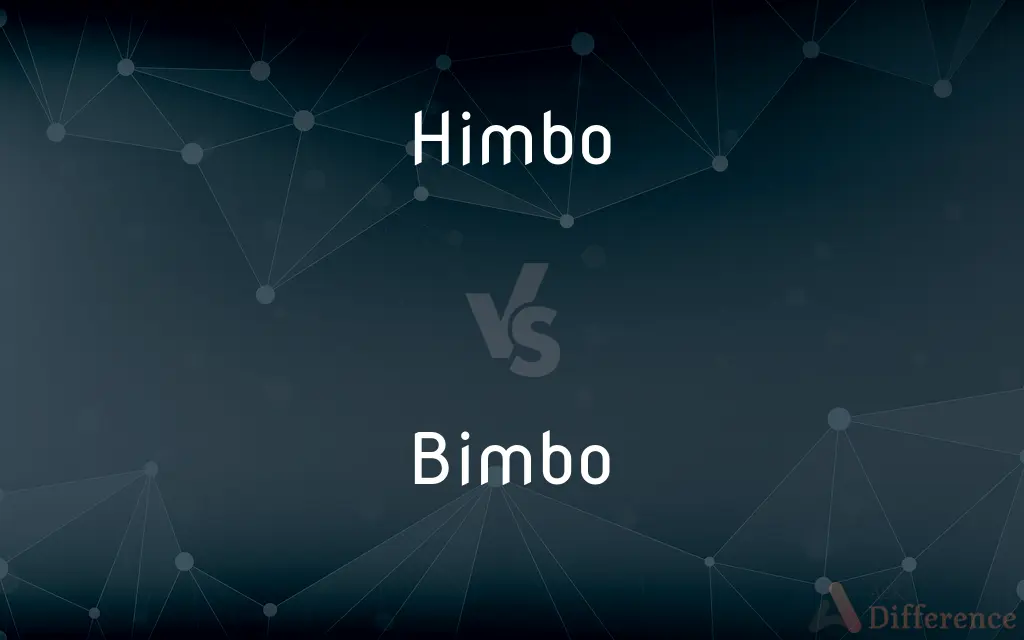Himbo vs. Bimbo — What's the Difference?
By Tayyaba Rehman & Maham Liaqat — Updated on April 8, 2024
Himbos are often depicted as attractive but not very intelligent men, while bimbos are their female counterparts, focusing on physical beauty over brains.

Difference Between Himbo and Bimbo
Table of Contents
ADVERTISEMENT
Key Differences
Himbos are typically characterized by their physical attractiveness and lack of intellectual depth, often portrayed as kind and well-meaning but not particularly bright. These men are celebrated more for their appearance and charm than for their intelligence or professional achievements. Whereas bimbos, the female equivalent, also emphasize physical beauty and are similarly depicted as lacking in intelligence. They are often shown in media as focused on maintaining their appearance and attracting male attention, sometimes at the expense of other qualities like intelligence or independence.
While himbos are seen in a somewhat positive light for their good nature and physical fitness, highlighting a non-threatening masculinity, bimbos are sometimes subjected to more negative stereotypes. This double standard reflects broader societal attitudes towards gender and intelligence. Whereas himbos might be admired or chuckled at for their simple-mindedness combined with a good heart, bimbos often face harsher criticism, suggesting a gender bias in how we perceive men and women with similar traits.
In terms of cultural representation, himbos have gained a form of endearing popularity, with characters in films and television shows often portrayed as lovable oafs who mean well. On the other hand, bimbos have been a staple of popular culture for longer, sometimes serving as cautionary tales about the dangers of valuing beauty over brains, though recent years have seen a reclaiming of the term with a more empowering connotation.
The himbo archetype tends to be celebrated for qualities such as kindness, loyalty, and physical strength, despite their lack of intellectual prowess. This contrasts with the bimbo, who is often depicted as manipulative or superficial, although both stereotypes are increasingly challenged and redefined in modern narratives.
Comparison Chart
Definition
Attractive, not very bright male
Attractive, not very bright female
ADVERTISEMENT
Stereotypical Qualities
Kind, physically fit, simple-minded
Beautiful, attention-seeking, superficial
Cultural Perception
Endearingly naive, challenges traditional masculinity
Often viewed negatively, but perception is changing
Representation in Media
Lovable oafs, good-natured
Focus on beauty, sometimes cautionary tales
Societal Impact
Challenges masculine ideals
Reflects and influences attitudes towards women
Compare with Definitions
Himbo
A man celebrated for his physical appearance over intellectual achievements.
He's known as a campus himbo, popular for his looks rather than his grades.
Bimbo
A woman who is often depicted as superficial or materialistic.
The novel's bimbo character obsesses over fashion and fame.
Himbo
A male character who is kind-hearted but lacking in depth.
The sitcom features a himbo who often misunderstands basic concepts.
Bimbo
A stereotype undergoing redefinition and empowerment.
The blogger reclaims the bimbo label, promoting beauty and brains.
Himbo
A lovable, if not particularly smart, male figure in media.
The himbo character in the novel wins over the family with his genuine kindness.
Bimbo
A female character focused more on appearance than substance.
She plays a bimbo in the play, highlighting societal expectations of women.
Himbo
A term reflecting non-threatening masculinity.
He embodies the himbo archetype, combining physical strength with a gentle personality.
Bimbo
A term used to describe women perceived as lacking depth.
She challenges the bimbo stereotype by excelling in her STEM career.
Himbo
An attractive but unintelligent man.
The movie's hero is a himbo who relies more on his muscles than his mind.
Bimbo
An attractive but unintelligent woman.
The film's antagonist is a bimbo who underestimates the protagonist's cunning.
Himbo
Himbo, a portmanteau of the words him and bimbo, is a slang term for an attractive but vacuous man. The first known use dates back to 1988.
Bimbo
An attractive but unintelligent or frivolous young woman.
Himbo
A physically attractive man who lacks intelligence; the male equivalent of a bimbo.
Bimbo
A physically attractive woman who lacks intelligence.
Bimbo
A stupid or foolish person.
Bimbo
A young woman indulged by rich and powerful older men
Common Curiosities
Why are himbos popular in media?
They offer a refreshing take on masculinity, emphasizing kindness over intellect.
Are bimbos always female?
Yes, bimbo traditionally refers to women, with himbo being the male counterpart.
How do himbos challenge masculine ideals?
By valuing emotional intelligence and physical strength over traditional intellectual superiority.
What is a himbo?
An attractive but not very bright man, often depicted as kind and physically fit.
Can himbos be smart?
Himbos are stereotypically not very bright, focusing more on physical attributes and kindness.
What makes a character a bimbo?
A focus on beauty and attractiveness at the perceived expense of intelligence.
Are there positive representations of bimbos?
Yes, modern narratives often portray them as more complex, challenging stereotypes.
What does bimbo mean?
Originally, an attractive but unintelligent woman, though the term's connotation is evolving.
Is the term bimbo offensive?
It can be, depending on context and usage, though some reclaim it positively.
Can bimbos be feminists?
Yes, redefining the term bimbo includes empowering women to embrace all aspects of their identity.
How are himbos and bimbos perceived in different cultures?
Perceptions vary, reflecting broader societal attitudes towards gender and intelligence.
What's the difference between a himbo and a hunk?
A hunk refers simply to a physically attractive man, without implications about intelligence.
Why do some people identify with the himbo/bimbo labels?
As a form of empowerment or to challenge and redefine societal expectations.
Are these terms evolving over time?
Yes, both terms are undergoing redefinition, reflecting changing societal values.
Do himbos have to be muscular?
While often depicted as physically fit, the core trait is their endearing simplicity.
Share Your Discovery

Previous Comparison
Object vs. Lesson
Next Comparison
Sumptuous vs. RichAuthor Spotlight
Written by
Tayyaba RehmanTayyaba Rehman is a distinguished writer, currently serving as a primary contributor to askdifference.com. As a researcher in semantics and etymology, Tayyaba's passion for the complexity of languages and their distinctions has found a perfect home on the platform. Tayyaba delves into the intricacies of language, distinguishing between commonly confused words and phrases, thereby providing clarity for readers worldwide.
Co-written by
Maham Liaqat














































